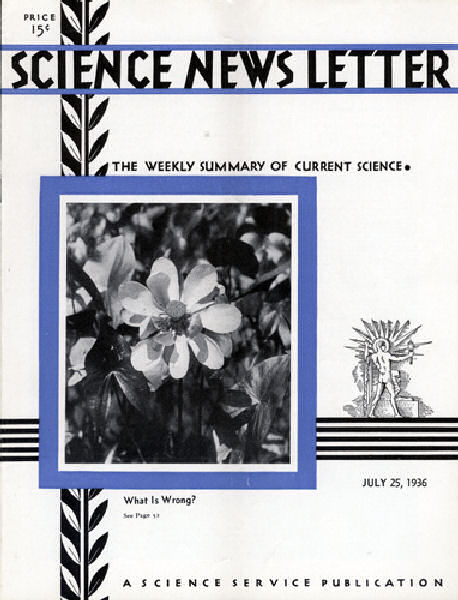From the July 25, 1936, issue

FLOWER PHOTO A “FOOLER” TO TRAP UNWARY BOTANISTS
What is wrong with the flower picture on the cover of this issue of the Science News Letter?
Take another look before you give an answer. (Only ambitious young botanists will be held responsible.)
Correct: The lotus flower and the arrowleaf foliage do not belong to each other. It is an Esau-and-Jacob picture—the flower is the flower of Nelumbo, but the leaves are the leaves of Sagittaria.
Another point on which local worthies sometimes fool the innocent—and in all innocence on their own part, too—is the claim you will often hear, in many places where the American lotus grows, that “This plant is found only here and in Egypt.”
Actually, this declaration gives America too little credit, and Egypt too much. The American lotus has a wide distribution in the central part of this country, and the famed lotus of the Nile was not a lotus at all but a white waterlily. The Old World lotus, a close cousin of the American species, is native to southern Asia. Buddha is quite properly associated with the lotus blossom, but not Osiris.
INSECTS CAN HEAR SOUNDS TOO LOW FOR HUMAN EARS
Insects can not only hear sounds too shrill for human ears to perceive, they can hear sounds too low-pitched for man to hear, as well. Certain kinds of crickets have a special hearing organ located at the rear end of the body, which is sensitive to very low-frequency vibrations, R.J. Pumphrey and A.F. Rawdon-Smith of Cambridge University have discovered. Locusts can hear super-shrill sounds by means of tiny bristles distributed all over them.
Messrs. Pumphrey and Rawdon-Smith did not depend merely on responses by the insects. They cut their heads off, connected the severed ends of nerves to highly sensitive amplifying hookups, and read responses to sound stimuli as “kicks” of a pointer on a dial.
OYSTERS SHUCK EASILY AFTER VINEGAR ANESTHETIZES THEM
Tight-mouthed oysters can now be made to open up automatically by a novel method of putting them under “ether,” which is described in a patent (No. 2,041,727) granted to H.F. Prytherch and Vera Koehring, U.S. Bureau of Fisheries workers, of Beaufort, N.C.
Before being put under the anesthetic, the oysters are given a “shock” treatment. This may be a good shaking up, an electrical shock, dropping them on a hard floor, or spinning them around in a centrifuge. Stupefied by such rough handling, the stunned oysters are then put into the “anesthetizing” solution, which may be nothing more than water containing a small amount of acetic acid, well-known ingredient present in ordinary vinegar. Real ether, chloroform, alcohol, and salts of many kinds may also be used for the purpose, however. Ten minutes to a half-hour in such a bath is sufficient to cause the oyster to open up automatically.
There is no breaking, puncturing, or prying open of the shell with knives as in the usual method of shucking oysters. The inventors solve the problem by making the oyster relax the powerful muscles that keep the shells closed and make it so hard to shuck oysters in the usual way. Shock and bathing in the anesthetizing bath are themuscle relaxers.
When the muscles relax, the shell opens. It is held open by the hinge cushion, which, like a spring wedge, exerts considerable pressure on the shells, forcing them apart.
While open, the meat can be removed from the oyster. Or, where the oysters are used in pearl culture, “seeds” can be planted in them and the oysters replaced in the sea water.







